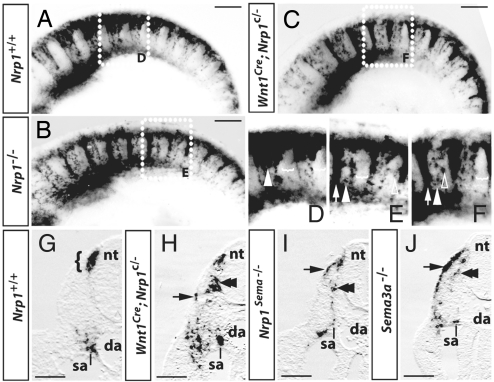Fig. 3.
SEMA3A/NRP1 signaling promotes NCC migration into the sclerotome. (A–F) In situ hybridization (ISH) for Sox10 at 9.5 dpc (22–25 somite stage); (D–F) are higher magnifications of the boxed areas in (A–C). NCCs preferentially migrated into the anterior sclerotome in wild-types (A), but into the intersomitic furrows in full Nrp1-null (B) or NCC-specific Nrp1-null mutants (C); as an example, 1 NCC stream in the anterior sclerotome is indicated with an arrowhead and 1 of the intersomitic streams with an arrow in (D–F). Whereas wild-type NCCs avoided the posterior sclerotome (indicated with brackets in D), mutant NCCs occasionally invaded the posterior sclerotome (clear arrowheads in E and F). (G–J) Transverse sections through the intersomitic furrow of a wild-type (G), NCC-specific Nrp1-null mutant (H), and mutants deficient in semaphorin signaling through NRP1 (I) or in SEMA3A (J); half of each section is shown. At the level of the intersomitic furrow, wild-type NCCs were only seen in the migration staging area (bracket) adjacent to the dorsal neural tube and in the sympathetic anlagen (sa); in contrast, many mutant NCCs migrated into the intersomitic furrow, where they segregated into a ventromedial (double arrowheads) and dorsolateral (arrow) stream. Consequently, NCCs were seen scattered over a wide area near the dorsal aorta. Abbreviations: da, dorsal aorta; nt, neural tube; sa, sympathetic anlage. (Scale bars, 250 μm.)

